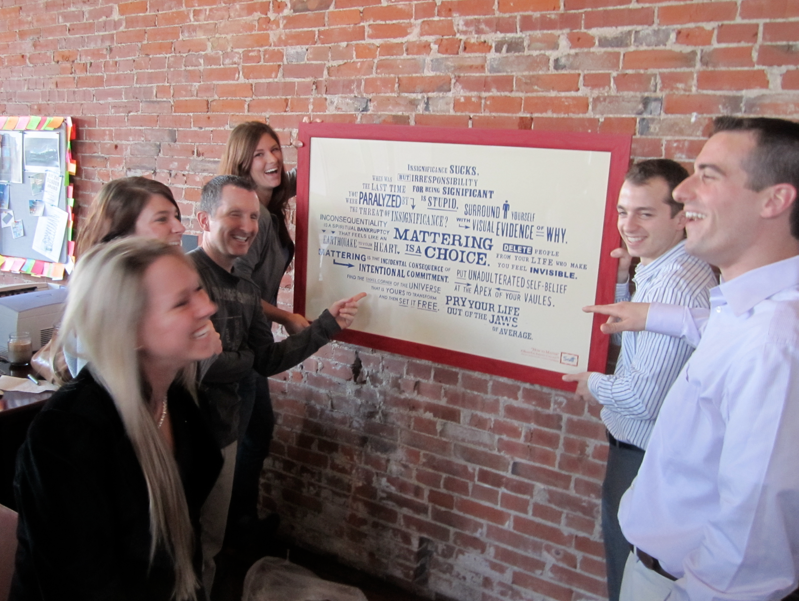
 You’ve chosen an uncertain path.
You’ve chosen an uncertain path.
You’ve adopted an inconvenient lifestyle.
You’ve embarked upon an unconventional journey.
You’ve felt the voice inside you growing more urgent.
You’ve committed yourself enough so you can’t turn back.
IN SHORT: You’ve decided to play for keeps.
This is the critical crossroads – the emotional turning point – in the life of every young artist.
I’ve been there myself. I’m still there myself. Here’s what I’ve learned lately:
1. Mainstream is lamestream. Going out in
front of an audience you’ve earned is everything. When you walk out there in
front of people who love what you do, who can’t wait to watch you do what you
do – and then you get to do it for them – everybody wins. The artist wins
because she’s not working for strangers anymore, she’s surrounded by the people
who actually get her, she’s free from free from the mediocrity of the masses
and she’s surrounded by the beauty of the tribe. The audience wins because
they’re getting what they paid for, they’re all in on the joke, they’re all
speaking the same language and they’re all in this together to root for someone
who is worthy of their hope. Sure beats performing cold to crowd of
crossed arms. Who loves you?
2. Patience is the highest form of trust. I’ve
always been an excellent producer. It’s just my nature. I’m impatient, I’m a
quick start and I’m an executor. I take action without waiting for permission,
and I turn a seed into a forest before most people realize it’s raining.
Lately, though, I’ve been practicing the fine art of waiting. Instead
of my normal tendency to drive towards closure, I’ve consciously created more
time for things to germinate than is comfortable. Instead of obsessing over the
branding of my next project, I’ve moved forward without satisfying my need to
label everything. It sucks. Letting go of a process that’s been good to
you is always a bitter pill to swallow. But despite my impulsive nature,
despite my predisposition to execute with all my might, I’m starting to learn
that anything worth doing is worth waiting for. What are you producing?
3. Consistency is far better than rare moments
of greatness. Houdini built his fame one escape at a time. He wasn’t a mentalist – he was an incrementalist.
Which certainly isn’t the quickest, sexiest or easiest path to success. And
it’s not what anyone is willing to tell us when we start our career. But great
art doesn’t take shortcuts. Harry worked for seven years before he got his big
break. Matter of fact, it wasn’t even that big of a break – just an
accumulation of small breaks that finally catapulted him to the next level.
Fortune may favor the bold, but it frequents the consistent. Are you making art one by one?
4.
The
problem with information. Anyone can deliver it, everyone can
find it and nobody can own it. And if
that’s all we bring to the table, there’s only so far our work can travel,
people will always be able to steal it and we’ll never have something truly
different to offer. The easiest way out is to simply tell our story. The one
that belongs to us. To make it as honest and bloody and human as possible, to
make it the only story we tell, and to make sure we’re the only ones who can
tell it. If we can pull that off, the information won’t matter. People won’t
have to worry about taking notes on everything we say, they’ll be taking notes
on themselves. Are people using your
story as a mirror to inspire themselves?
5. Remove what robs you. Before
he became a famous sculptor and light installation artist, Dan Flavin was a
floor guard of American Museum of Natural History. According to his biography,
during night shifts Dan would cram his uniform pockets with notes and sketches
for an electric light display. Not surprisingly, he was more interested in
creating art for the future than protecting artifacts from the past.
Eventually, the custodian in charge said, “We aren’t paying you to be an
artist.” Flavin agreed and quit. Three years later, Dan’s first solo
exhibition debut and launched his career as one of contemporary art’s greatest
minimalist. He removed what robbed him, embraced what excited
him and spent his life doing things that tapped into who he was
made to be. What do you need to quit?
6. Please the right audience. There are
two types of disc jockeys. The ones who fill the floor, and the ones who fiddle
with music. Both take skill, both require creativity and both are forms of art.
What’s different is the energy. The posture. The level of engagement. The sense
of community. When an organization invests hundreds of thousands dollars to
throw a party, they don’t want their guests sitting in chairs, sipping
champagne, watching some guy with headphones scratch records. People can do
that in their homes. What they want is for people to come together, embrace
each other, share the joyful experience of music and dance and celebration, and
not leave the dance floor until the lights flicker on and it’s time to go home.
That’s irreplaceable. It all depends on whom the performer is trying to please:
If it’s only themselves, then they’re just masturbating; but if it’s the entire
room, then everybody gets laid. Which
type are you?
7. Trust your mission. In his biography,
Charles Schultz explained that the secret of his success was focusing on
drawing one good comic strip every day. Not
making millions. Not achieving fame. Not changing the world. Not advancing his
personal agenda. Not making publishers and newspapers happy. Just the art.
Just the work. Just one good strip, every day. That single goal, that
incrementalist approach, governed Schultz’s work for more than fifty years, and
it made him the most influential, popular and profitable cartoonist in the
history of the medium. The strip was his mission piece. That one chunk of art
he committed to, focused on and obsessed over, each day, until it was done, no
exceptions; trusting that everything else – the television specials, the
merchandising, the books – would flow from that. What’s your mission piece?
REMEMBER: When you’re ready to play for keeps, your work will never be the same.
Make the decision today.
Show the world that your art isn’t just another expensive hobby.
LET ME ASK YA THIS…
Have you committed with both feet yet?
LET ME SUGGEST THIS…
For the list called, “52 Random Insights to Grow Your Business,” send an email to me, and you win the list for free!
* * * *
Scott Ginsberg
That Guy with the Nametag
Writing, Publishing, Performing, Consulting
scott@hellomynameisscott.com
 My job is to help companies make their mission more than a statement, using limited edition social artifacts.
My job is to help companies make their mission more than a statement, using limited edition social artifacts.
Want to download your free workbook for The Brandtag Strategic Planning Crusade?
Meet Scott’s client from Nestle Purina at www.brandtag.org!
